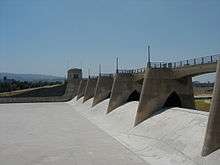Dry Canyon Reservoir
| Dry Canyon Reservoir | |
|---|---|
|
| |
| Location | Los Angeles County, California |
| Coordinates | 34°29′04″N 118°31′44″W / 34.484493°N 118.529003°WCoordinates: 34°29′04″N 118°31′44″W / 34.484493°N 118.529003°W |
| Type | reservoir |
| Primary inflows |
Los Angeles Aqueduct Dry Canyon Creek |
| Primary outflows |
Los Angeles Aqueduct Dry Canyon Creek |
| Max. length | 780 feet (240 m) |
| Surface area | 1,100 acre-feet |
| Water volume | 72,750 cu ft (2,060 m3) |
| Surface elevation | 1,455 feet (443 m) |
| Islands | None |
| Settlements | Santa Clarita |
Dry Canyon Reservoir is a small reservoir formed by an embankment dam on Dry Canyon Creek in the Sierra Pelona Mountains of northern Los Angeles County, California, just over 6 miles (9 km) north the city of Santa Clarita. It was designed a part of the Los Angeles Aqueduct system.
History

Constructed from 1910 to 1912, the 72,750 cu ft (2,060 m3) lake with a surface elevation of approximately 1,514 feet (461 m) above sea level regulated the flow of water from the irregular flow discharged from the power plants in San Francisquito Canyon. The incoming water from San Francisquito came from Tunnel 77 and the outgoing water went out Tunnel 78. Water from the lake was distributed via the Los Angeles Aqueduct to the northern portion of the Greater Los Angeles Area.[1][2]
Draining the Reservoir
Following damages incurred by the dam itself during the 1952 Kern County earthquake and growing concerns over its structural integrity, the reservoir was drained in 1966. Since the early 1970s, efforts had been made to refill the reservoir but these plans have since been abandoned due to high costs. In the decades that followed, the suburban communities of Santa Clarita had grown northward to fill the narrow valley just downstream. The course of Dry Canyon Creek south of the reservoir was then funneled down a concrete wash to prevent flooding of the surrounding communities.
Today, the empty reservoir only provides flood control during storms. The lakebed itself has become home to a significant growth oak trees and other chaparral shrubs.
See also
- List of dams and reservoirs in California
- List of lakes in California
- St. Francis Dam
- Bouquet Reservoir
- Dry Canyon Formation
